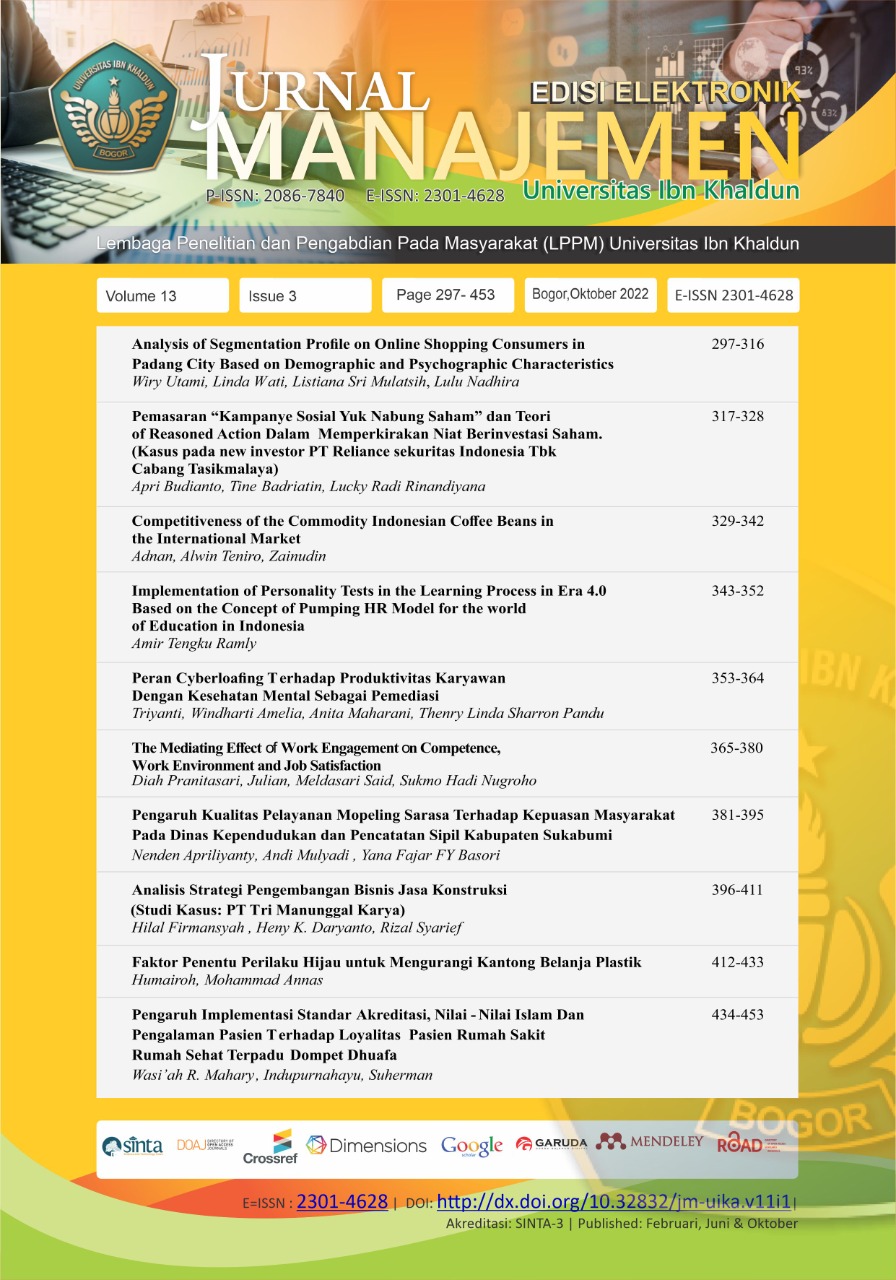Analisis Strategi Pengembangan Bisnis Jasa Konstruksi (Studi Kasus: PT Tri Manunggal Karya)
DOI:
https://doi.org/10.32832/jm-uika.v13i3.8081Keywords:
analytical hierarchy process, construction, EFE, IE matrix, IFE, SWOTAbstract
Increasing competition of construction business in Indonesia forces PT Tri Manunggal Karya (PT TMK) to innovate to survive in the construction industry. One way is by having a competitive strategy for its business development. As a holding company, a proper strategy is highly required by PT TMK to open up market opportunities for the company and its subsidiaries and to avoid the risk of business failure and financial losses. This study aims to analyze internal and external factors and analyze the priority strategies for PT TMK development. The analytical methods used were Internal Factor Evaluation (IFE) Analysis, External Factor Evaluation (IFE) Analysis, Strength, Weakness, Opportunity, and Threats (SWOT) Analysis, Analytical Hierarchy Process (AHP) Analysis. The result shows that the external condition of PT TMK is in a high position in responding to opportunities and threats. Its internal figures are in a strong stand in utilizing strengths and overcoming its weaknesses. Opportunity in the company's industry can be concluded because infrastructure development and competent human resources are still limited in the Eastern parts of Indonesia. The threats are post-pandemic conditions and fast-growing construction technology. The result of the Analytical Hierarchy Process (AHP) shows the strategy of acquiring new business units is considered as the main priorities, followed by expansion out of Java Island.
References
Amin, A.M., Baga, L.M. and Tinaprilla, N. 2018.Strategi Perencanaan Model Bisnis Perusahaan Jasa Konsultan Arsitektur dan Jasa Kontraktor PT Architectaria Media Cipta. MANAJEMEN IKM: Jurnal Manajemen Pengembangan Industri Kecil Menengah, 13(1), pp. 55–65. doi:10.29244/mikm.13.1.55-65.
Arief, A.M. 2021.Kontraktor Asing Bertambah, PUPR: Mereka Sudah Ada Rencana. Bisnis.com, 20 April, p. 1. [Online]. Available at: https://ekonomi.bisnis.com/read/20210420/45/1383768/kontraktor-asing-bertambah-pupr-mereka-sudah-ada-rencana [Accessed: 12 May 2022].
Chowdhury, T., Adafin, J. and Wilkinson, S. 2019.Review of Digital Technologies to Improve Productivity of New Zealand Construction Industry. Journal of Information Technology in Construction, 24, pp. 569–587. doi:10.36680/J.ITCON.2019.032.
David, F. 2002.Concepts of Strategic Management (Edisi Bahasa Indonesia). Jakarta: PT Prenhallindo, Pearson Education Asia Pte. Ltd.
GAPENSI. 2020.Jumlah Anggota Gapensi Seluruh Indonesia. GAPENSI. [Online]. Available at: https://gapensi.or.id/statsanggota [Accessed: 12 November 2020].
Gayathri, N. and Chiranjeevi, T. 2018.SWOT Analysis of Construction Industry. International Journal of Research, 7(9), pp. 1731–1733.
Hadad, S. 2015.Analytic Hierarchy Process Analysis for Choosing A Corporate Social Entrepreneurship Strategy. Management and Marketing, 10(3), pp. 185–207. doi:10.1515/mmcks-2015-0014.
Julison, B., Wardani, S.P.R. and Wibowo, M.A. 2017.Innovation Performance of Large Contractor in Indonesia: Influencing Factors and its Impact on Firm's Performance. Procedia Engineering, 171, pp. 370–378. doi:10.1016/j.proeng.2017.01.346.
Khedr, M.S. 2017.A Look into the Immediate Impact of Zohr on Egypt's LNG Import Bill. Egypt Oil and Gas News Paper, 5 November, p. 1. [Online]. Available at: https://egyptoil-gas.com/features/a-look-into-the-immediate-impact-of-zohr-on-egypts-lng-import-bill/ [Accessed: 5 November 2020].
Manurung, A. 2011. Restrukturisasi Perusahaan: Merger, Akuisisi dan Konsolidasi, serta Pembiayaannya(1st edn). Jakarta: PT Adler Manurung Press.
Melati, M. and Siwi, D.F.R. 2019.Analisis Perbandingan Kinerja Finansial Pt Astra International Tbk Pasca Akuisisi terhadap PT General Electric Services. Oikonomia: Jurnal Manajemen, 15(2), pp. 113–130. doi:10.47313/oikonomia.v15i2.749.
Muhlis, Shafaryantoro, M. and Kuncasari, L. 2018.Construction Statistics 2018. Edited by R. Ismail et al. Jakarta: BPS-Statistics Indonesia.
Nainggolan, E.D.H. 2011.Strategi Peningkatan Daya Saing Untuk Meningkatkan Profit Perusahaan Jasa Konstruksi (Kontraktor) Studi Kasus Rekanan PT. X. Thesis. Depok: Universitas Indonesia.
Riahi, A. and Moharrampour, M. 2016.Evaluation of Strategic Management in Business with AHP Case Study: PARS House Appliance. Procedia Economics and Finance, 36(16), pp. 10–21. doi:10.1016/s2212-5671(16)30011-9.
Schönbeck, P., Löfsjögård, M. and Ansell, A. 2020.Presence in Construction Project Research. Buildings, 10(10), pp. 11–15. doi:10.3390/buildings10100173.
Sultika, B. and Hartijasti, Y. 2017.Fakto Faktor yang Memengaruhi Kreativitas dan Orientasi Inovasi di Tempat Bekerja. Jurnal Riset Bisnis dan Manajemen Tirtayasa, 1(2), pp. 180–199.
Supriadi, L.S.R. and Pheng, L.S. 2018.The Indonesia Construction Industry: Business continuity management in construction. Singapore: Springer.
Syahputra, R. 2017.Analisis Pengembangan Model Bisnis Properti PT Hasta Raya Utama. Dissertation. Bogor: Bogor Agriculture University.
Triyawan, A. and Fendayanti, Z.E.U. 2021.Dampak Pandemi Covid-19 terhadap Keberlangsungan Perusahaan Jasa Konstruksi. Forum Ekonomi, 23(2), pp. 223–230.
Yuliana, C. and Kartadipura, R.H. 2017.Model Strategi Pemasaran Jasa Konsultansi Kontraktor Di Kalimantan Selatan. Rekayasa Sipil, 11(2), pp. 108–115. doi:10.21776/ub.rekayasasipil/2017.011.02.4.
Downloads
Published
How to Cite
Issue
Section
License
Authors who publish with this journal agree to the following terms:
- Authors retain copyright and grant the journal right of first publication with the work simultaneously licensed under a Creative Commons Attribution-NonCommercial-ShareAlike 4.0 International License that allows others to share the work with an acknowledgement of the work's authorship and initial publication in this journal.
- Authors can enter into separate, additional contractual arrangements for the non-exclusive distribution of the journal's published version of the work (e.g., post it to an institutional repository or publish it in a book), with an acknowledgement of its initial publication in this journal.
- Authors are permitted and encouraged to post their work online (e.g., in institutional repositories or on their website) prior to and during the submission process, as it can lead to productive exchanges, as well as earlier and greater citation of published work (See The Effect of Open Access).











